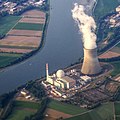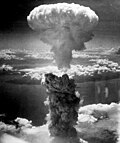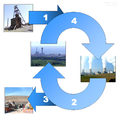Portal:Nuclear technology Source: en.wikipedia.org/wiki/Portal:Nuclear_technology
The Nuclear Technology Portal
Introduction

- Nuclear technology is technology that involves the nuclear reactions of atomic nuclei. Among the notable nuclear technologies are nuclear reactors, nuclear medicine and nuclear weapons. It is also used, among other things, in smoke detectors and gun sights. (Full article...)
- Nuclear power is the use of nuclear reactions to produce electricity. Nuclear power can be obtained from nuclear fission, nuclear decay and nuclear fusion reactions. Presently, the vast majority of electricity from nuclear power is produced by nuclear fission of uranium and plutonium in nuclear power plants. Nuclear decay processes are used in niche applications such as radioisotope thermoelectric generators in some space probes such as Voyager 2. Reactors producing controlled fusion power have been operated since 1958 but have yet to generate net power and are not expected to be commercially available in the near future. (Full article...)
- A nuclear weapon is an explosive device that derives its destructive force from nuclear reactions, either fission (fission or atomic bomb) or a combination of fission and fusion reactions (thermonuclear weapon), producing a nuclear explosion. Both bomb types release large quantities of energy from relatively small amounts of matter. (Full article...)
General images -
Selected article -
After the Fall of France, some French scientists escaped to Britain with their stock of heavy water. They were temporarily installed in the Cavendish Laboratory at the University of Cambridge, where they worked on reactor design. The MAUD Committee was uncertain whether this was relevant to the main task of Tube Alloys, that of building an atomic bomb, although there remained a possibility that a reactor could be used to breed plutonium, which might be used in one. It therefore recommended that they be relocated to the United States, and co-located with the Manhattan Project's reactor effort. Due to American concerns about security (many of the scientists were foreign nationals) and patent claims by the French scientists and Imperial Chemical Industries (ICI), it was decided to relocate them to Canada instead.
The Canadian government agreed to the proposal, and the Montreal Laboratory was established in a house belonging to McGill University; it moved to permanent accommodation at the Université de Montréal in March 1943. The first eight laboratory staff arrived in Montreal at the end of 1942. These were Bertrand Goldschmidt and Pierre Auger from France, George Placzek from Czechoslovakia, S. G. Bauer from Switzerland, Friedrich Paneth and Hans von Halban from Austria, and R. E. Newell and F. R. Jackson from Britain. The Canadian contingent included George Volkoff, Bernice Weldon Sargent and George Laurence, and promising young Canadian scientists such as J. Carson Mark, Phil Wallace and Leo Yaffe.
Although Canada was a major source of uranium ore and heavy water, these were controlled by the Americans. Anglo-American cooperation broke down, denying the Montreal Laboratory scientists access to the materials they needed to build a reactor. In 1943, the Quebec Agreement merged Tube Alloys with the American Manhattan Project. The Americans agreed to help build the reactor. Scientists who were not British subjects left, and John Cockcroft became the new director of the Montreal Laboratory in May 1944. The Chalk River Laboratories opened in 1944, and the Montreal Laboratory was closed in July 1946. Two reactors were built at Chalk River. The small ZEEP went critical on 5 September 1945, and the larger NRX on 21 July 1947. NRX was for a time the most powerful research reactor in the world. (Full article...)
Selected picture -
Did you know?
- ... that T. K. Jones thought that a nuclear war was survivable if "there are enough shovels to go around"?
- ... that after a 2008 tornado, Michael Chertoff likened Picher, Oklahoma, to a nuclear bomb site?
- ... that Project Ketch proposed the detonation of a 24-kiloton nuclear device in Pennsylvania to create a natural-gas storage reservoir?
- ... that Trump wrote a letter to Ali Khamenei in an effort to initiate new nuclear negotiations with Iran?
- ... that an Iowa TV station was paid for by surplus Manhattan Project funds?
- ... that before becoming a successful children's author, Myron Levoy was an engineer doing research on nuclear-powered spaceships for a mission to Mars?
Related WikiProjects
Things you can do
| Parts of this portal (those related to section) need to be updated. Please help update this portal to reflect recent events or newly available information. Relevant discussion may be found on the talk page. (September 2021) |
|
Here are some Open Tasks :
|
Selected biography -
After service on the Western Front with the Royal Field Artillery during the Great War, Cockcroft studied electrical engineering at Manchester Municipal College of Technology whilst he was an apprentice at Metropolitan Vickers Trafford Park and was also a member of their research staff. He then won a scholarship to St. John's College, Cambridge, where he sat the tripos exam in June 1924, becoming a wrangler. Ernest Rutherford accepted Cockcroft as a research student at the Cavendish Laboratory, and Cockcroft completed his doctorate under Rutherford's supervision in 1928. With Walton and Mark Oliphant, he built what became known as a Cockcroft–Walton generator. Cockcroft and Walton used this to perform the first artificial disintegration of an atomic nucleus, a feat popularly known as splitting the atom.
During the Second World War Cockcroft became Assistant Director of Scientific Research in the Ministry of Supply, working on radar. He was also a member of the committee formed to handle issues arising from the Frisch–Peierls memorandum, which calculated that an atomic bomb could be technically feasible, and of the MAUD Committee which succeeded it. In 1940, as part of the Tizard Mission, he shared British technology with his counterparts in the United States. Later in the war, the fruits of the Tizard Mission came back to Britain in the form of the SCR-584 radar set and the proximity fuze, which were used to help defeat the V-1 flying bomb. In May 1944, he became director of the Montreal Laboratory, and oversaw the development of the ZEEP and NRX reactors, and the creation of the Chalk River Laboratories.
After the war Cockcroft became the director of the Atomic Energy Research Establishment (AERE) at Harwell, where the low-powered, graphite-moderated GLEEP became the first nuclear reactor to operate in western Europe when it was started on 15 August 1947. This was followed by the British Experimental Pile 0 (BEPO) in 1948. Harwell was involved in the design of the reactors and the chemical separation plant at Windscale. Under his direction it took part in frontier fusion research, including the ZETA program. His insistence that the chimney stacks of the Windscale reactors be fitted with filters was mocked as Cockcroft's Folly until the core of one of the reactors ignited and released radionuclides during the Windscale fire of 1957.
From 1959 until his death in 1967, he was the first Master of Churchill College, Cambridge. He was also Chancellor of the Australian National University in Canberra from 1961 to 1965. (Full article...)
Nuclear technology news
- 25 June 2025 – Middle Eastern crisis
- United States strikes on Iranian nuclear sites
- A preliminary assessment by the U.S. Defense Intelligence Agency finds that Iran's nuclear program may have only been set back by a few months after the U.S. airstrikes, with the centrifuges required to enrich uranium left largely intact, contradicting previous claims made by U.S. president Donald Trump that the facilities were "obliterated". (AP)
- After U.S. president Donald Trump rejects the DIA assessment as "fake news", U.S. Central Intelligence Agency director John Ratcliffe says that the CIA assesses that several key Iranian nuclear facilities were severely damaged in the airstrikes, likely requiring years to rebuild. (BBC News)
- 23 June 2025 – Middle Eastern crisis
- A United Nations fact-finding mission reports that Israeli strikes on Iran’s state broadcasting agency and killing of Iranian nuclear scientists were likely in violation of international humanitarian law. (Al Jazeera)
Related portals
Related topics
Subcategories
Associated Wikimedia
The following Wikimedia Foundation sister projects provide more on this subject:
-
Commons
Free media repository -
Wikibooks
Free textbooks and manuals -
Wikidata
Free knowledge base -
Wikinews
Free-content news -
Wikiquote
Collection of quotations -
Wikisource
Free-content library -
Wikiversity
Free learning tools -
Wiktionary
Dictionary and thesaurus



































































































